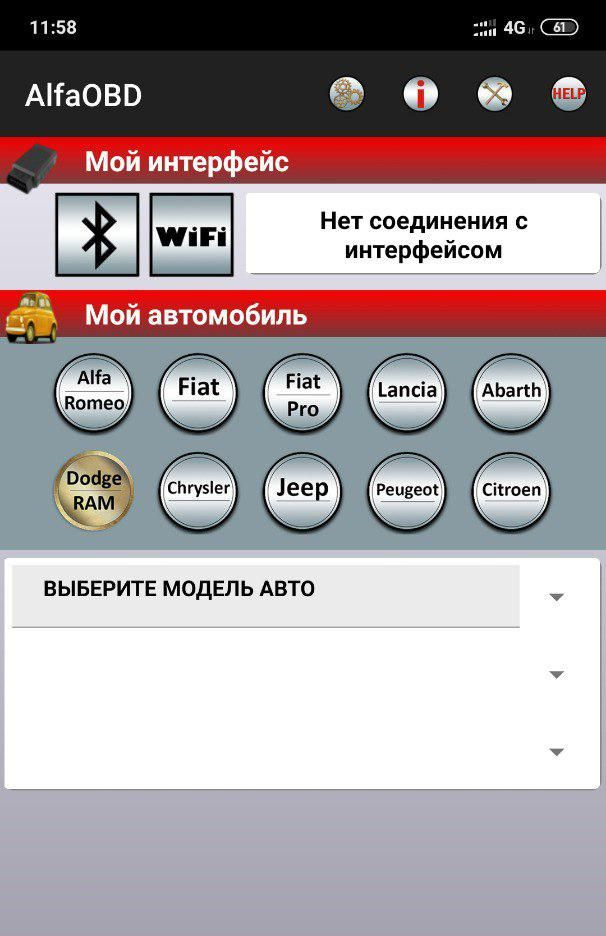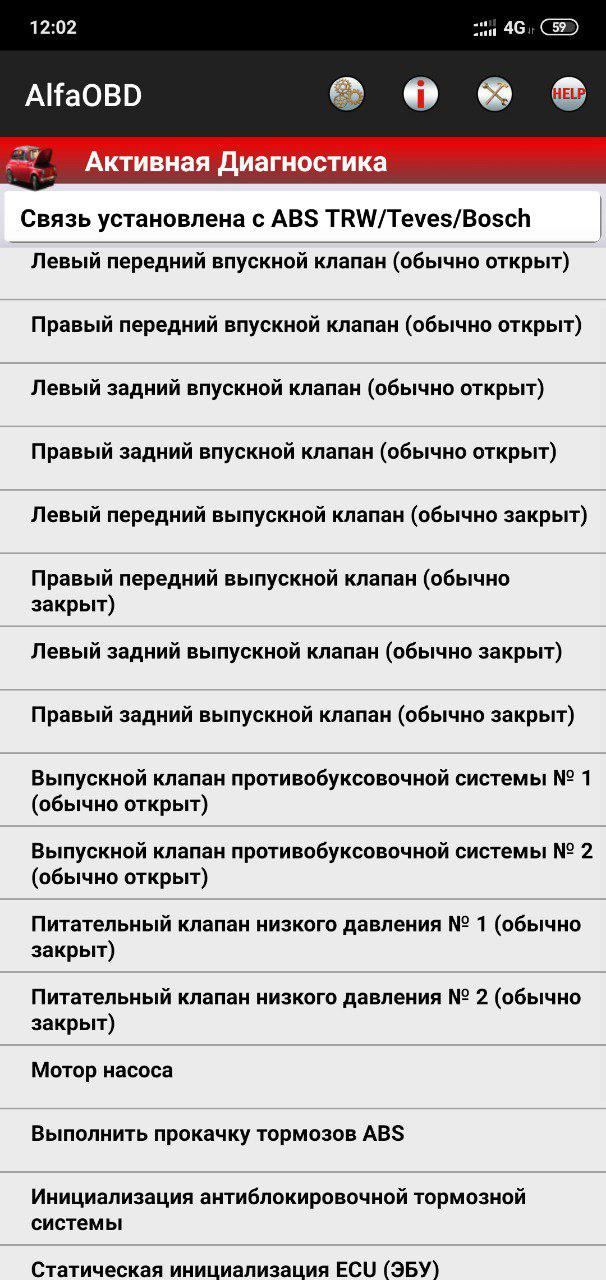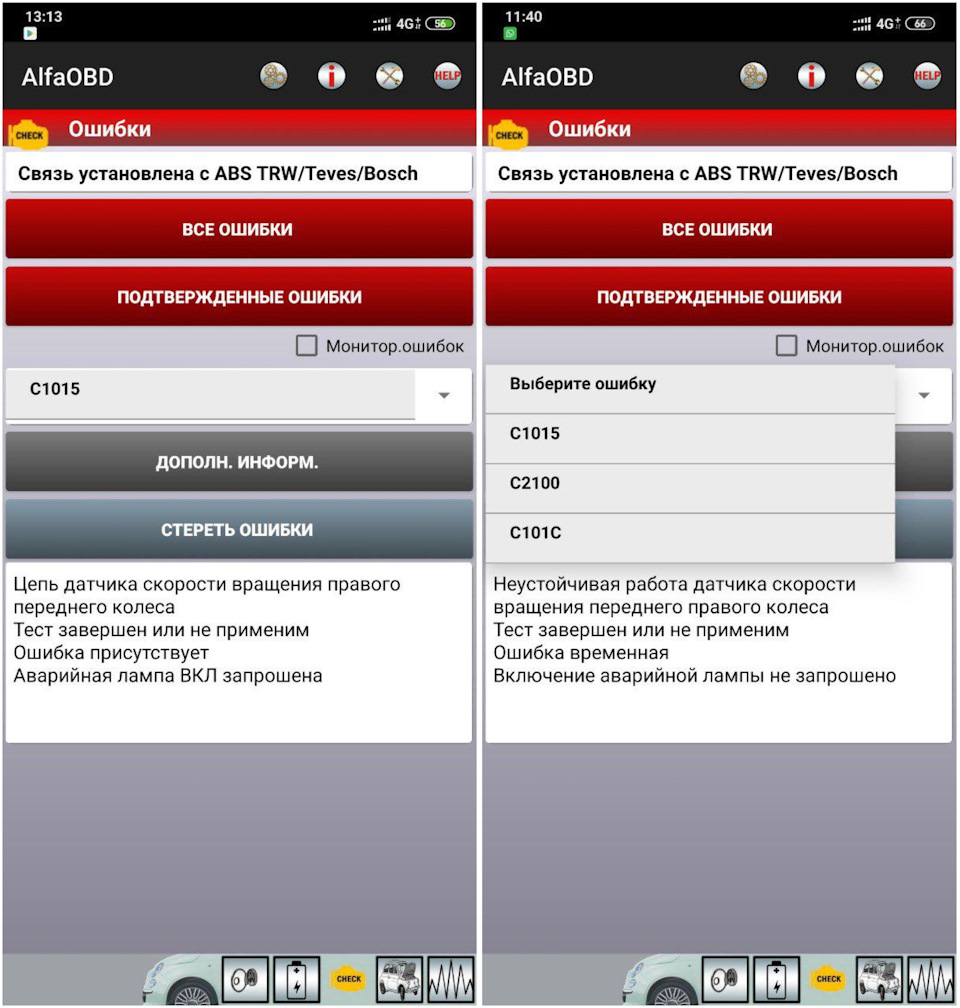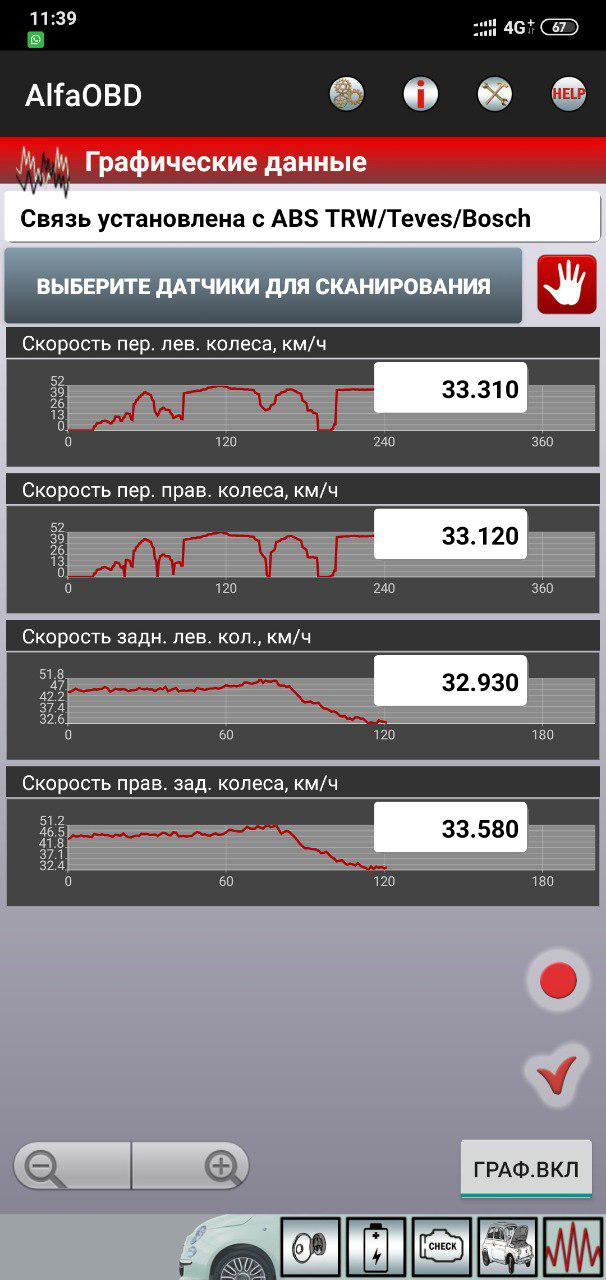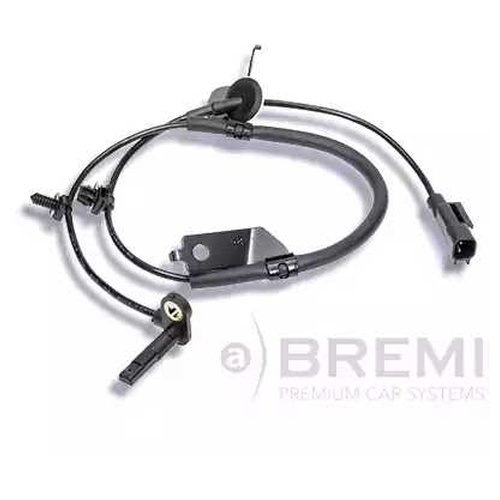Давным-давно, ещё со времён, когда у меня не было ДХО и особых знаний о машине, появилась у меня ошибка U1418 — неверные данные скорости правого колеса. Достаточно расплывчатая расшифровка, да. Но все программы выдавали только эту информацию. Это могла быть как и ступица, так и датчик ABS, или вообще блок ABS. Ошибка на приборке была «плавающей», она то появлялась, то исчезала. Самое неприятное, когда она появлялась — обычно это могло произойти при торможении. На ровной, сухой дороге начинает срабатывать ABS, а через пару секунд вырубается и вываливается ошибка ABS|ESP — соответственно, отключался не только ABS, но и система стабилизации, и «антибукс».
Вскоре диагностика показала, что у меня умерла ступица. Передняя правая. Это самое простое объяснение ошибки U1418. Правая передняя ступица, как было мне сказано — самая нагруженная, поэтому выходит из строя быстрее всего. Замена ступицы… Помогла! Но на некоторое время. Ошибка всё равно появлялась, но намного реже. Это не сильно напрягало, если честно, но было неприятно. В последнее время ошибка горела постоянно. Чистка разъёма помогла, но совсем ненадолго.
И вот, спустя много лет, добрался я-таки до AlfaOBD. Это программа, больше известная в кругах АльфаРомео и Фиата. Но, как оказалось, они расширились и до уровня Chrysler! Если кто не знает, то JS — это не только несколько моделей Крайслера и Доджа, но и… Fiat Flavia. Точно также, как Dodge Journey — это Fiat Freemont. Платформа — совсем не означает, что могут быть одинаковыми как внутренние, так и внешние блоки. Но всё-таки приложение AlfaOBD начало работать с ChryslerGroup (кстати, ещё и до французов PSA добрались, но это уже другая история)
Приложение работает по протоколам OBDKey, KLLine или ELM327. В Китае все покупают именно ELM327. Как оказалось, для нормальной работы приложения требуется ЕЛМ-ка с версией протокола 1.5. Так-то для нашего авто вполне подходит дешёвый 2.1, но для нормального чтения параметров просто необходим реальный 1.5 (ну, или официальный 2.1 за очень немаленькие деньги). Почему 2.1 не подходит — читайте в интернетах. Если очень коротко, то китайцы не смогли нормально «скопировать» официальный 2.1, поэтому он просто обрезок.
На просторах Али была закуплена проверенная ELM v1.5 по очень приятной цене (ссылка на товар: ru.aliexpress.com/item/32334039714.html, из-за жадности Drive2 надо кликать дважды, тогда попадёте на кешбек-ссылку от Drive2, или копировать ссылку в буфер и вставлять в новом окне). Проверка показала, что это и вправду ELM v1.5
В приложении AlfaOBD выбираем нужную нам модель (можно и поиграться, например, в Chrysler JS есть ещё один блок, которого нет в Dodge JS). Подключаемся к нужному нам блоку и наблюдаем просто офигенный функционал
ВНИМАНИЕ! Лишний раз лучше не играться. Блок может выйти из строя или могут сбиться какие-то серьёзные настройки!
Сначала была проведена проверка клапанов ABS (ну захотелось поиграться с разными блоками, чего уж там) — проблем не обнаружено, насос, клапана всё работает стабильно и без ошибок. Даже прокачку тормозов через блок ABS провёл 
Проверка на ошибки показала наличие нескольких, которые обычные сканеры а-ля Torque не видели
Далее сбросил ошибки и дождался её появления, это позволило увидеть условия, при которых появилась ошибка (на деле нифига это не дало, но всё-таки приятно контролировать всё).
Ну и, конечно же, тестовые испытания в нескольких экземпляров. Сначала навешал кучу датчиков (хотя бы посмотреть, какие считываются), в итоге оставил просто датчики скорости колёс. Ошибка ABS|ESP светится, а датчики показывают правильную скорость, которая не разнится другими колёсами (видно и по графику, и по снимку момента скорости).
Всё это дало пищу к размышлениям. Ошибки вполне явно указывали на то, что была потеря связи между колесом и блоком ABS. А это ни что иное, как датчик ABS. Мониторинг рынка показал достаточно слабый выбор — оригинал (3.5 — 5 тыр), и неоригиналы JapanParts, Bremi, MagTechnic и Ashika (900-2000 рублей). Выбор пал на среднюю ценовую категорию, но, вроде, неплохого качества — Bremi 50746
Об установке рассказывать нечего особо — поднял машину, снял правое переднее колесо, открутил крепление датчика к поворотному кулаку, отсоединил разъём датчика к ABS под капотом в районе крыла под бачками ГУР и антифриза, выдернул клипсы крепления к кузову (можно не нежничать, расстёгивая стяжку, у Bremi полный комплект) и всё — старый датчик в руках. Установка в обратном порядке. Единственное, что НЕ понравилось у Bremi — провод будто бы перекручен в некоторых местах. Как я ни старался уложить аккуратно, напряжение в оплётке чувтсовалось. Будем надеяться, что это не помешает работе!
Итоговый заезд показал, что ошибка пропала сама собой и больше не появлялась. На данный момент пробег уже около 100 км, никаких ошибок нет!
Вот так простая, но глубокая диагностика помогает решить проблему
Расшифровка ошибки U1418 у Dodge: Высокое напряжение в системе
Марка:
Уклонение
Код:
U1418
Определение:
Высокое напряжение в системе
Описание:
P0563 Зажигание включено на 10 секунд.
Причина:
TCM обнаруживает, что напряжение в системе составляет 18 вольт или больше в течение 10 секунд.
Опрос: Где ремонтируется Ваш автомобиль? (Кол-во голосов: 2667)
У себя в гараже
У официалов
В гараже у Васи
Чтобы проголосовать, кликните на нужный вариант ответа.Результаты
From english:
Decoding the error U1418 from Dodge: System Voltage High
Make:
Dodge
Code:
U1418
Definition:
System Voltage High
Description:
P0563 The ignition is ON for 10 seconds.
Cause:
The TCM detects system voltage is 18 volts or greater for 10 seconds.
Еще ошибки категории
Ошибки автомобилей разных произвродителей
Опрос: Смогли ли диагностировать неисправность? (Кол-во голосов: 444)
Да, лично
Да, с помощью знакомого
Да, у официального дилера
Нет
Чтобы проголосовать, кликните на нужный вариант ответа.Результаты
Расскажите друзьям:
Поставьте рейтинг, для нас это очень важно:
Голосов: 0 чел. Рейтинг: 0 из 5.
Степень важности ремонта : 3
Степень сложности ремонта : 3
- Неисправный датчик скорости автомобиля
- Неисправен модуль антиблокировочной системы тормозов (ABS)
- Жгут проводов модуля антиблокировочной системы тормозов разомкнут или закорочен
- Некачественное электрическое соединение цепи модуля антиблокировочной системы тормозов
- Неисправность модуля управления трансмиссией (PCM).
Как исправить код u1418 dodge?
Начните с проверки ‘Возможных причин’, перечисленных выше. Визуально осмотрите жгут проводов и разъемы. Проверьте наличие поврежденных компонентов и поищите сломанные, погнутые, вытолкнутые или проржавевшие контакты разъема
Сколько стоит диагностика кода u1418 dodge?
Трудозатраты: 1. 0
Стоимость диагностики кода U1418 Dodge составляет 1,0 час труда. Время диагностики и трудозатраты автосервиса зависят от местоположения, марки и модели автомобиля и даже типа двигателя. Большинство авторемонтных мастерских взимают плату от 75 до 150 долларов США в час
Каковы возможные симптомы кода u1418 dodge?
- Горит лампа двигателя (или предупреждающая лампа Service Engine Soon).
Что означает код u1418 dodge?
Модуль управления силовым агрегатом (PCM) получает сообщения о скорости вращения колес и расстоянии между колесами по шине Controller Area Network (CAN) C от модуля антиблокировочной системы тормозов (ABS). Диагностический код неисправности (DTC) устанавливается, когда модуль управления силовым агрегатом либо не получает сообщение шины, либо получает недостоверное сообщение шины от антиблокировочного тормозного модуля
| Code | Fault Location | Probable Cause |
|---|---|---|
| U1418 | Implausible Left Wheel Distance Signal Received (Chrysler, Dodge, Jeep) (Buy Part On Amazon) |
We recommend Torque Pro
Table of Contents
- What Does Code U1418 Mean?
- Where is the U1418 sensor located?
- What are the common causes of code U1418?
- What are the symptoms of code U1418?
- Get Help with U1418
What Does Code U1418 Mean?
OBD II fault code U1418 is a manufacturer-specific trouble code that is defined by car makers Dodge, Chrysler, and Jeep as “Implausible Left Wheel Distance Signal” or sometimes as “Implausible Left Wheel Distance Signal Received”, and is set when the PCM (Powertrain Control Module) detects an inaccurate, implausible, erratic, or corrupted signal from the wheel speed sensor from one of the vehicle’s left wheels, as opposed to from a specific left wheel.
NOTE: In the context of code U1418, and any other codes relating to wheel distances on the listed applications, the word “distance” refers to the horizontal distance a wheel covers through one complete revolution of the wheel. While this distance is “known”, in the sense that it is programmed into several control modules, it is nevertheless dependent on the correct wheels and tires being fitted, and that all wheels are inflated to their specified inflation pressures.
Although wheel speed sensors have the primary function of supplying the ABS control module with information regarding the rotational speed of each wheel, these sensors also perform several other functions. In terms of the ABS, the wheel speed sensors monitor the rotational speed of each wheel to prevent the brakes from locking up under severe braking. In practice, the ABS control module compares the rotational speeds of the wheels continually via the wheel speed sensors, and when it detects that one or more wheels are rotating more slowly than the other wheels during braking, it will momentarily (and repeatedly) release the brake pressure on those wheels until all wheels again rotate at the same speed.
However, other systems like traction control, stability control, hill descent, and others also use primary input data from the wheel speed sensors to maintain or restore the vehicle’s stability through selective brake applications to individual wheels via the ABS during sudden or violent direction changes. In these cases, the algorithms that control the ABS require accurate input data on both the rotational speed of the wheels and the distance that each wheel covers during a full wheel rotation, the latter being a function of the wheel diameter.
This data is compared to data obtained from the steering angle sensor and other sensors such as yaw rate sensors, which is in turn compared to the distance that each wheel covers during a full rotation of each wheel. This comparison has two objectives; the first is to verify that all the wheels are rotating and that even though all wheels are rotating, all wheels cover a distance that is equal to their circumference as a means to identify potentially dangerous situations, such as a slide or a skid.
During normal vehicle operation, the distance each wheel covers during a full rotation is monitored continually, regardless of the wheels’ rotational speeds both as a means to verify the integrity of input data from each wheel sensor and to monitor the stability of the vehicle. Thus, when the PCM and/or the ABS control module detects an implausible signal from one of the vehicle’s left wheels, it concludes either that the wheel is covering a bigger or smaller distance than it should, or that the wheel sensor is generating inaccurate data about the rotational speed of the wheel.
This input data is particularly important for the listed applications because the correct operation of the AWD (All Wheel Drive) system depends on all the wheels covering the same distance during each revolution of each wheel. Of course, during cornering, the inside wheels rotate slower than the outside wheels, but the crucial factor here is that the inside and outside wheels still cover the same distance during each revolution, regardless of the wheels’ rotational speed.
In a fully functional AWD system, the engine’s power is vectored between the front and rear wheels by a control module and the changes in torque vectoring are typically seamless and undetectable by an average driver. However, if a condition such as a partially deflated tire on either a front or a rear left wheel occurs, the affected wheel’s diameter is slightly smaller than the (correctly) inflated right wheels, meaning that the affected left wheel will cover a slightly smaller distance during each revolution than the (correctly) inflated right wheels.
Since the vehicle’s suspension systems react to uneven road surfaces, a partially deflated wheel could briefly cover different distances as the vehicle’s weight is “lifted’ off the wheels on uneven road surfaces. Under these conditions, the control module that controls torque vectoring will engage the AWD system during the brief moments when all the wheels cover the same distance and disengage the AWD system when the wheels do not cover the same distance, depending on how often the distance the partially deflated wheel covers changes.
As a practical matter, this creates a situation where the AWD system is engaged and disengaged in rapid succession, and in many cases, this is accompanied by load mechanical “clunking” or “thudding” noises each time the AWD system disengages. This is a serious condition and unless it is corrected promptly, serious damage to the vehicle’s drive train could result.
Thus, when the PCM or another control module detects an implausible signal, regardless of which left wheel is implicated, or the root cause of the inaccurate or implausible data, the PCM, or one or more other control modules will set code U1418 and illuminate one or more warning lights. Note also that depending on the vehicle, the PCM or other control modules may deactivate safety systems such as ABS, cruise control, stability control, and traction control (among others) as a safety precaution since these systems all depend on accurate input data from all the wheel speed sensors to work as intended. In all cases, though, normal braking will still be available.
Where is the U1418 sensor located?
The image above shows the typical location of a wheel sensor relative to the drive shaft and brake system.
Note the “teeth” on the reluctor ring; during normal operation, the teeth each create a small magnetic field when they pass in front of the sensor. This field is converted into an electrical current, and the resulting number of “ON” pulses thus created is counted by various control modules, and then converted into the rotational speed of the wheel, based on the frequency of the “ON” pulses.
Note that in the context of code U1418, the distance the wheel covers is a function of the number of teeth on the reluctor ring, which means that the distance a wheel covers during a full rotation can be monitored independently of the wheel’s rotational speed.
What are the common causes of code U1418?
Some common causes of code U1418 could include one or more of the following-
- Damaged, burnt, disconnected, shorted, and/or corroded wiring in the affected wheel speed sensors’ wiring harness
- Defective wheel sensor and/or reluctor ring on one or both left wheels as the result of impacts by road debris. Note that while this is rare, it does happen.
- Use of some aftermarket replacement sensors
- Different wheel sizes on the left side of the vehicle; note that if a different wheel size is used in an emergency, several safety or driver assist systems may be deactivated
- On some vehicles with permanent AWD systems, a partially deflated wheel will sometimes be interpreted by the PCM as a defective wheel speed sensor
- Failed or failing PCM, but note that since this is a rare event, the fault must be sought elsewhere before any control module is replaced
What are the symptoms of code U1418?
Common symptoms of code U1418 could include the following-
- Stored trouble code and one or more illuminated warning lights
- IN some cases, multiple additional codes relating to the operation of the AWD system may be present along with U1418
- Several safety systems, including ABS, cruise control, stability control, and traction control or may be deactivated
- If fitted, selectable electronic AWD may not be available
- Load mechanical noises may be present as the result of the rapid engagement/disengagement of the AWD system
NOTE: As a general rule, most, or all driver assist systems that use the ABS to function may be disabled or deactivated automatically by the PCM or one or more other control modules when codes such as U1418 or other wheel speed sensor-related codes are present.
Help Us Help You
Please comment below describing your issue as well as the specifics of your vehicle (make, model, year, miles, and engine),
and one of our mechanics will respond as soon as possible. We appreciate a $9.99 donation via the payment button below.
Эпопея с системой охлаждения!
О замене бачка писал, опишу проблему подробнее, возможно кому-то пригодится.
Из бачка стал уходить антифриз, видимых потёков не было, я напрягся и стал наблюдать.
Смотрел на уровень в бачке после ночной стоянки, система ж должна остыть, давление выровняться. Во время пуска двигателя смотрел на выхлопные газы. Почитал статьи про систему охлаждения, все пишут про прогоревшие прокладки, в общем жуть. Продолжалось это несколько месяцев. Антифриз периодически уходил, а я его подливал. Однажды поднял капот сразу после поездки по городу и вижу блестит коса проводов, которая проходит примерно под бачком. Трогаю её пальцем — палец красный. Думаю вот оно. Начинаю лазить искать. Включил фронтальную камеру на телефоне и засунул телефон под бачок, а там висит капля и дренажная трубка мокрая.

Всё вытер, выровнял уровень в бачке и стал ждать. А антифриз не уходит.
В итоге моих наблюдений оказалось, что на самом дне бачка, в самой его нижней точке, похоже образовалась микротрещина. При езде по городу, когда система охлаждения максимально разогревалась и создавалось максимально высокое давление, бачок начинал течь. Но тёк не сильно, поэтому до утра в подкапотном всё высыхало.
При этом автомобиль 2017 года, какого хрена бачок треснул непонятно.
Поставил новый бачок, заменил на нём крышку, и уже как порядка 2000 км этой проблемы нет. Но фобия осталась и литр антифриза всегда лежит в багажнике.
Всем добра и крепких бачков!

